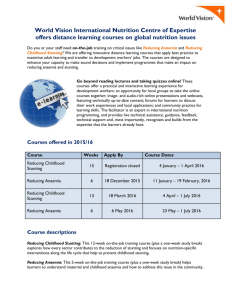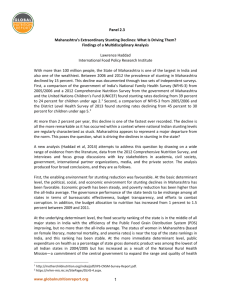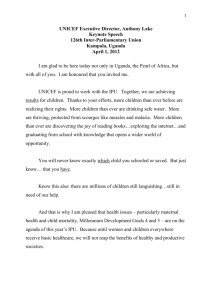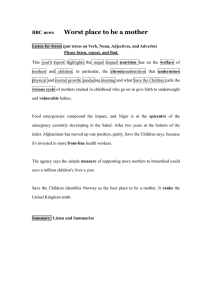Report on Stunting Prevention Workshop
advertisement
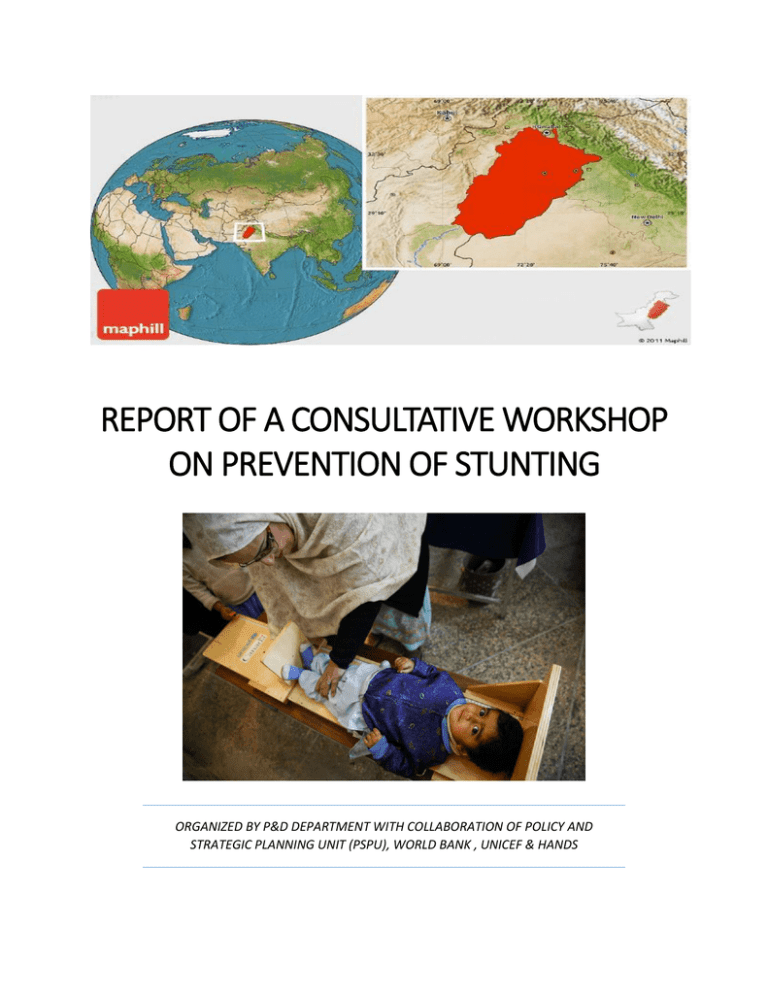
REPORT OF A CONSULTATIVE WORKSHOP ON PREVENTION OF STUNTING ORGANIZED BY P&D DEPARTMENT WITH COLLABORATION OF POLICY AND STRATEGIC PLANNING UNIT (PSPU), WORLD BANK , UNICEF & HANDS March 7, 2016 Contents ACKNOWLEDGEMENT: ..................................................................................................................................................3 ACRONYMS ....................................................................................................................................................................4 INTRODUCTION .............................................................................................................................................................5 BACKGROUND ...............................................................................................................................................................5 NUTRITION STATUS IN PAKISTAN: .................................................................................................................................5 NUTRITIONAL STATUS IN PUNJAB: ................................................................................................................................6 WHAT IS STUNTING .......................................................................................................................................................6 OBJECTIVES OF THE WORKSHOP: ..................................................................................................................................7 PROCEEDINGS OF WORKSHOP: .....................................................................................................................................7 DISCUSSION SESSION ...................................................................................................................................................11 COMMENTS .................................................................................................................................................................13 Way Forward: ..............................................................................................................................................................13 Vote of Thanks: ............................................................................................................................................................13 Pictures Gallery: ...........................................................................................................................................................14 AGENDA .......................................................................................................................................................................19 Page 2 of 23 LIST OF INVITEES ..........................................................................................................................................................21 Report on Stunting Prevention Workshop Rev (1) ACKNOWLEDGEMENT : Page 3 of 23 This report, developed by Policy and Strategic Planning Unit (PSPU), Health Department, is based on the deliberations of the workshop entitled ‘Stunting Prevention Workshop’ held in Lahore, Pakistan on 7th March 2016. The report benefited from the suggestions and inputs of all those present at the meeting. Financial support in arranging the meeting and the necessary logistics by World Bank, UNICEF and HANDS is gratefully acknowledged Report on Stunting Prevention Workshop Rev (1) ACRONYMS Annual Development Plan Civil Society Organization Housing urban development & Public Health Engineering Department Health And Nutrition Development Society Infant and Young Child Feeding Multi-sectoral Nutrition Strategy Planning and Development Department Policy & Strategic Planning Unit Scaling Up Nutrition Water Sanitation & Hygiene Lady Health Worker Health Care Provincial Behaviour Change Communication Page 4 of 23 ADP CSO HUD&PHED HANDS IYCF MSNS P&DD PSPU SUN WASH LHW HCP BCC Report on Stunting Prevention Workshop Rev (1) INTRODUCTION The Government of Punjab (GoP) has been making significant investment in the health care delivery system of the province to provide quality and timely services to the population and improve their health status indicators. This includes an aggressive stance in streamlining systems and sectors through set up of sector reform programs, e-monitoring, accountability and governance systems etc. Establishing Policy and Strategic Planning Unit (PSPU) is at the core of this approach along with other initiatives such as development and implementation of Health Roadmap and Reform Programs. PSPU is at a critical juncture, liaising with international development partners in rationalizing priority agendas and organizing the work done. Although improving, the overall pace of progress in the achievement of the provinces’ health goals is far than desirable. There are multiple reasons attributable to the same such as lack of planning capacity, weak coordination amongst sectors, departments, development partners and donors, poor implementation mechanisms, paucity of resources and duplication of efforts to name a few. BACKGROUND Malnutrition is at a rise globally. It includes prevalence of underweight, wasting, stunting and overweight. Two billion people suffer from various forms of malnutrition and in 2011 undernutrition contributed to over 3.1 million child deaths worldwide. Pakistan’s progress in achieving MDG targets regarding reducing the prevalence of malnutritionby 50% has not been satisfactory. The National Nutritional Survey 2011 showed that amongst children, stunting increased from 37% to 43.7% and wasting increased from 13% to 15.1% between 2001 and 2011. Nutritional status NNS 2001 NNS 2011 Rural2011 Urban2011 Stunting 37% 43.7% 46% 37% Wasting 13% 15.1% 15% 10% Report on Stunting Prevention Workshop Rev (1) Page 5 of 23 NUTRITION STATUS IN PAKISTAN: NUTRITIONAL STATUS IN PUNJAB: Under-nutrition status MICS 2011 MICS 2014 Underweight (Severe +Moderate) 29.8% 33.7% Stunting( Severe + Moderate) 39.2% 33.5% Wasting ( Severe+ moderate) 13.7% 17.5% To tackle the problem of malnutrition, Multi-sectoral Nutrition Strategy (MSNS) was prepared under guidance of P&D department with technical support from UNICEF and development partners and input from departments concerned (Food, Health, Agriculture, Livestock, Fisheries, Education, Social Protection and Public Health and Engineering. MSNS was approved in January 2015 and launched in September 2016 and is now in the implementation phase. World Bank Country President in his recent meeting with the Chief Minister, Punjab, highlighted the grave situation of stunting and malnutrition in the province. This workshop was organized as a sequelto this meeting to review the progress of relevant programs and sectors and develop a work plan/roadmap for future to enhance the momentum for a speedy progress, this first consultative stunting prevention workshop has been organized by the collaboration of P&D and PSPU with the support of World Bank , UNICEF and HANDs. WHAT IS STUNTING Stunting is an enormous drain on economic productivity and growth. Economists estimate that stunting can reduce a country’s GDP by as much as 12%. Every year, stunting is the cause of one million child deaths around the world. Maternal and child undernutrition is the cause of 3.5 million deaths annually (Black et al, Lancet Series on Nutrition, January 2008). For the children who survive, stunting in infancy and early childhood causes lasting damage, including poor cognition Report on Stunting Prevention Workshop Rev (1) Page 6 of 23 A child who doesn’t grow well and is too short for his age suffers from a condition known as stunting. Good nutrition is critical to support the rapid growth and development of babies and young children during their first 1,000 days i.e. the period from conception to two years of age (minus 9 months to plus 24 months). Without good nutrition however, a young child can suffer serious and often permanent damage to his developing brain and body. We can’t really see this damage but we can measure it by looking at how well a child is or isn’t growing. A child who is stunted or chronically malnourished often appears to be normally proportioned but is actually shorter than normal for his/her age. and education performance, reduced lean body mass, lower productivity, reduced adult wages and pregnancy complications. Chronic malnutrition or stunting is devastating to young children: impaired brain development, lower IQ, weakened immune systems and greater risk of serious diseases like diabetes and cancer later in life Tackling malnutrition including stunting requires a multisectoral approach. In this workshop,there was a focus on interventions to prevent stunting from the Multisectoral Nutrition Strategy which is a comprehensive document highlighting the role of all relevant sectors to undertake nutrition sensitive and specific interventions to address malnutrition which includes stunting and wasting. OBJECTIVES OF THE WORKSHOP: This workshop had the following objectives: To get an overview of malnutrition with a focus on Stunting Preparation of draft action plan/roadmap identifying the role of different sectors/actors including private sector and media to prevent stunting Sharing of case studies/ innovation /success stories across the globe for prevention of stunting To get feedback from stakeholders as what can be short term, medium term and long term interventions to tackle stunting in the province. Stunting Prevention Workshop was held on 7thMarch, 2016 at the P&D Department. This workshop was organized by P&D department with collaboration of PSPU, World Bank, UNICEF and HANDS. The workshop was attended by Mr. Mohammad Jehanzaib Khan (Chairman P&D Department), Mr. Ali Jaan Khan (Special Secretary Primary & Secondary Healthcare Department), Dr. Shabana Haider (Member Health, P&D Department), Mr. Ali Bahadur Qazi (Program Director, PSPU), Mr. Saleem Masih (Chief Health, P&D Dept.), Dr. Zahida Sarwar (Additional Program DirectorTech, PSPU), Dr. TayyabMasud (Team Leader, World Bank), Dr. Tahir Manzoor (UNICEF), Dr. Tallat Pasha (VC, UVAS), Dr. Sheikh Tanveer Ahmed (HANDS), Ms. Angela Cespedes (Head of Nutrition, WFP), Dr. Tayyaba Wasim (Professor Obs&Gyane, SIMS). Representatives from Public and Private Sectors including UHS, Contech International, FJMC, HUD & PHE Department, Fisheries Department, Food Department and Micronutrient Initiatives (MI) also participated in the workshop. Report on Stunting Prevention Workshop Rev (1) Page 7 of 23 PROCEEDINGS OF WORKSHOP: Following the recitation of Holy Quran and formal welcome address,Dr. Shabana Haider(Member Health P&D Board) highlighted that malnutrition especially stunting affects the economic growth of the Pakistan causing 3% loss of GDP annually. She emphasized that to tackle this issue we need to have a comprehensive roadmap/action plan. Multi-sectoral Nutrition Strategy (MSNS) has strategic action plans and there is high need at this point in time to identify those activities which can be helpful in tackling stunting. She also informed that a Nutrition Cell will be formed in P&D to facilitate all sectors for the implementation of their sectoral plans and also work as a coordinating body for all relevant stakeholder. She expressed her commitment and told that one on one meeting with all secretaries would be arranged by P&D to expedite the implementation of their sectoral plans and also for the development of new schemes to be incorporated in ADP. Mr. Ali BahadurQazi(Program Director, PSPU)gave a brief overview and explained objectives of the workshop. He highlighted that stunting is an emerging problem and Government of Punjab is taking necessary action to handle it. Though efforts are being made but in order to achieve the MDG Goal of reducing stunting from 39% to 20% by 2020we need to speed up our progress.The objectives of the workshop were that all stakeholders deliberate on stunting prevention and through their valuable inputs an action plan to be devised for the future. Dr. Tallat Naseer Pasha(VC, UVAS)elaborated therole of UVAS in preparation of MSNS.MSNS developed after a long consultative process by various stakeholders. It is high time for sectors to come up with concrete action plans so they can be included in the ADP of coming year. Unfortunately the activities mentioned in MSNS are not been reflected in action plans of few sectors. In Livestock reduction of import duty of powder milk (25% to 20%, India 70%) adversely affects the dairy industry,moreover poor quality processed milk is being sold in the market without labelling of its contents. He further added that dairy products available in market are for adults like tea whiteners whereas children need good quality butter and pure milk for improving nutrition. Agriculture sector is in crisis because policies of agriculture sector are not favorable for agriculture promotion. He hoped that with the lead role of P&D these challenges may be sorted out on priority. Report on Stunting Prevention Workshop Rev (1) Page 8 of 23 Mr. TayyabMasud(Team Leader, World Bank)stated that large number of children are affected by stunting(39% of Pakistan’s children) constituting - 4.8 Million childrenunder 5. He explained themain causes of stunting which included poor maternal health, inadequateinfant young child feeding, repeated infections, poor personal hygiene & sanitation and low maternal education. It was agreed that there is need to address these issues on war footing. The need is to prioritize nutrition on the provincial agenda andensure multisectoral collaboration. There is need to strengthen the capacity and systems to develop and implement plans, according to set objectives and timelines and establish strong accountability and monitoring frameworks. He highlighted that a 1% loss in adult height due to stunting is associated with a 1.4% loss in economic productivity. For implementation of MSNS resources are needed along with a very prompt M&E and accountability system Dr Zahida Sarwar (Additional Program Director Technical, PSPU) gave a presentation on the intervention for Stunting Prevention in the light Of MSNS. She gave a brief overview of the process of development of MSNS, and the role of various sectors in it. She identified some areas that need to be focused on priority to prevent stunting that included promotion of adolescent health, promotion of maternal education, antenatal care, delivery by skilled birth attendants, postnatal care,immunization, early initiation of breastfeeding and exclusive breastfeeding and healthy timing and spacing of pregnancy. In addition to this, provision of safe water and sanitation is also very critical to prevent stunting. Extracting action areas for stunting prevention from MSNS, she discussed the latest updates of various sectors especially health and education and challenges faced by sectors.Challenges included low coverage of Lady Health Worker, nonimplementation of Breastfeeding Act, freely available formula milk,noimplementation of baby friendly hospital regulations, lack of communication activities, lack of promotion of simple measures like handwashing, boiling water and community mobilization to prevent open defecation. Other areas that need due attention are food quality regulation (food storage, control on harmful pesticides, labelling), food security, fortification, conditional cash transfer schemes for the poor and school curriculum revision. Angela Cespedes(Nutrition Head, WFP) discussed case study of stunting prevention program in Thatta&Sajawaldistricts, its intermediate outcome and trends. She highlighted that 80% of brain development occurs in1000 days of life requiring optimal quality and quantity of nutrients. She explained in detail the project including objectives, key features and project designs.The project interventions included giving mothers nutrients (SNF), IYCF and hygiene promotion along with breastfeeding promotion activities. The results of project showed there was a reduction of 11% in stunting in children 6-23 months old after 9 months intervention .As a way forward it was suggested that there is need for enhanced BCC and social mobilization activities, IYCF and hygiene promotion, improving length/height measurement skills of LHWs and HCP, ensuring proper utilization of SNF and improved coordination amongst partners for implementing nutrition specific and sensitive interventions Findings of the project are given below: Key Preliminary Findings of RCT Nutrition Status of Children 6-23 months: Page 9 of 23 The graphs show the reduction in stunting at ninth follow-up (after nine months intervention) was 11% (548*100/61.5=89.1) means remaining 10.9% is stunting reduction. Report on Stunting Prevention Workshop Rev (1) Mr. Fahad (Provincial Coordinator, HUD & PHED)gave a very comprehensive overview of his departments initiatives for stunting prevention. He apprised the participants that diarrheal diseases are a major contributor to stunting and its prevalence in children in Punjab is 17.4%. WASH interventions reduced the frequency by diarrhoea by almost a third – Hygiene (37%); Sanitation (32%); Clean water (31%); and multiple (33%). Hand washing reduced the risk of diarrhoea by 30%. Improvements in sanitation were associated with increases in height ranging from 0.8 cm to 1.9 cm. Page 10 of 23 Focused areas of WASH are equitable access to safe & clean water, Promoting best practices &behavioural change regarding hygiene practices, equitable access to Total Sanitation Services and development and implementation of policies and strategies. The commendable efforts made by their department was reflected in their sectoral progress review and was highly appreciated by Member Health P&D. Report on Stunting Prevention Workshop Rev (1) Dr. Tahir Manzoor, (Health & Nutrition Specialist, UNICEF)mentioned that nutrition partners include P&D Department, SUN Secretariat, PSPU, IRMNCH & N, Nutrition Sector DGHS, all relevant sectors (Health, Food, Agriculture, Livestock, Fisheries, WASH, Social Protection, Education Department) and Development Partners (World Bank, DFID, UNICEF, WHO, HANDS, TRF plus, USAID Deliver, MI, GAIN, etc). Better coordination between all sectors and donor partners is mandatory to ensure effective implementation of MSNS which in turn will result in decrease in stunting prevalence in the province.To prevent duplication of efforts and resource, all donors and development partner need to share their area of work along with the progress with each other during TWG meetings which is actually a platform of coordination between all donors/development partners and all sectors. Member Health recommended that anutrition related development partners /donorsmeeting should be held for better collaboration in their activities. Dr. Sheikh Tanveer Ahmed(CE0, HANDS and Chairperson SUN CSO Alliance)shared future opportunities, possibilities and challenges of stunting in Punjab. He briefed about HANDS workin Pakistan and told about the various programs including, community based health workers model, community outreach program with nutrition, immunization and health education, promotion of ANC and nutritional counseling, and early childhood development intervention. HANDS has implemented integrated development models for improving nutrition and health. HANDS also provided support for promotion of breastfeeding, IYCF,Livelihood schemes and WASH facilities. He expressed his desire to provide support to Punjab in Awareness raising/ Behaviour Change Communication at gross roots level (particularly promoting health and hygiene, highlighting importance of balance diet, promoting breastfeeding etc.), Advocacy for budgetary allocations and implementation of laws and integration of nutrition programming in regular annual development programs. DISCUSSION SESSION Report on Stunting Prevention Workshop Rev (1) Page 11 of 23 Mr. FaizRasoolChaudhry(Nutrition Advisor, Contech International) stressed the importance of private sector, media and civil society organizations in stunting prevention. These sectors have an important role in the mobilization of the community and should play an active role for improving nutrition of the population. Strategies to be adopted by private sector are improved policy and regularity environment to support IYCF interventions and practices, create shape and support demand for improved IYCF and increase supply demand and use of fortified complementary foods along with support for education and agriculture sector.Civil Society has an important role as peoples participation ensures their ownership for various health promotion activities which helps in implementation. Women empowerment is equally important and needs due attention. Media helps spread information and has an important role in generating awareness and bringing about behavioral change. Dr Tahir Manzoor (UNICEF) mentioned for community screening of adolescent girls, LHWs need to be provided necessary equipment like height board, weighing scales along with necessary training. Dr Shabana Haider (P&D D) suggested regarding shortage of LHWs, it would be desirable to have some multipurpose healthcare providers and requested development partners to support in this regards. Dr Rameeza Kaleem (FJMU)suggested healthcare providers at RHCs, BHUs, THQs and DHQs should have integrated approach while dealing with reproductive maternal and child health and urban slums need to be focused. Dr. Usman Jawad (UHS)suggested that rather than the term maternal education the strategy should focus on parental education. LHWs participate in health promotion but we need to strengthen our BHUs, RHCs & THQs to deal with referred patients. There should be a proper mechanism of screening/checkups of children up to five years of age and we need to explore the option of engaging GPS (general practitioners ) from private sector to assist the government in providing primary healthcare services. Ms. UzmaKhurram(UNICEF) said the Population Welfare department also needs to be taken on board for the stunting prevention. Dr. Noorullah, (IRMNCH & N ) stated that reverting to traditional and simple ways of living can be a solution to all nutrition problems .Moreover we need to realize our individual responsibilities rather than just relying on government initiatives. . Dr Shabana Haider ( P&DD)requested various sector representatives to discuss problems faced by their respective departments for planning and implementing nutrition related activities. Dr. Shabbir, (Livestock Department) said that they face financial constraints in their various projects. Budget cuts has affected a project in which sheeps and heifersare given to widow women. Dr. Muhammad Aslam, (Agriculture department) mentioned that pulses cultivation project and vegetable enhancing projects are important initiatives for nutrition promotion in which farmers are given seeds free of cost, along with setting up demonstration plots. Kitchen gardening scheme needs to be promoted, moreover multiplication of Zincol requires additional resources for which they need support of P&D for seeking funds. Report on Stunting Prevention Workshop Rev (1) Page 12 of 23 Dr. Zahida Sarwar presented the stunting prevention frame work with key areas to be focused. She invited all the stakeholders to give their valuable inputs to develop short term, medium term and long term interventions. COMMENTS Mr. Muhammad Jehanzaib(Chairman P&D)commented that all actions need to be very tangible. MSNS is present and now we need to put in resources and take immediate actions. Due to limited resources it’s essential to prioritize actions. Team work with full commitment and dedication is the need of the hour.Planning and development department ensure it full support for this cause and need to utilize its monitoring and evaluation wing to follow progress of all activities.All department representatives should discuss with their heads about the issues addressed in this workshop and emphasize the need for immediate actions to implement MSNS. Mr. Ali Jaan Khan(Secretary Primary & Secondary Healthcare Department) appreciated P&D departmentinitiative to take a lead rolefor stunting prevention. P&D is in a position where it can influence other department. The role of WASH, population welfare and local government is important. It has been seen that there is third party validation for measuring the progress of activities. He suggested that a baseline study be conducted to identify causes of stunting in various district of Punjab and after identifying the causes plan interventions accordingly. We need to device a mechanism to track the changes and tailor interventions according to emerging needs. We need to critically evaluate LHWs program and see how to redesign it to get better outcomes in future. Follow up donor meeting to be conducted to develop an action plan/roadmap Increase LHWs Coverage or identify some alternative options like multipurpose community health workers with the donors support to bridge the gap. Implementation of Breastfeeding Act and imposing legislative check on sale of formula products. Establishment of nutrition cell to implement MSNS with resources (human resource deployment and Capacity building, logistics and finances, M & Evaluation System) Community representatives participation.( ownership, mobilization) Ongoing Research to identify innovative approaches. Vote of Thanks: Meeting ended with a vote of thanks by Member Heath Planning & Development Department. Report on Stunting Prevention Workshop Rev (1) Page 13 of 23 Way Forward: Page 14 of 23 Pictures Gallery: Report on Stunting Prevention Workshop Rev (1) Page 15 of 23 Report on Stunting Prevention Workshop Rev (1) Page 16 of 23 Report on Stunting Prevention Workshop Rev (1) Page 17 of 23 Report on Stunting Prevention Workshop Rev (1) Page 18 of 23 Report on Stunting Prevention Workshop Rev (1) AGENDA Stunting Prevention Workshop 7th MARCH, 2016 P&D DEPARTMENT, Lahore ACTIVITY 09.30 AM Registration 10.00 AM Recitation of the Holy Quran 10.10 AM Round of Introduction 10.20 AM 10.30 AM 10.40 AM Welcome address and objectives of meeting Brief introduction of Workshop Overview of Malnutrition 10.50 AM TEA BREAK 11:00 AM 11.10 AM 11.20 AM 11.30 AM Interventions to prevent Stunting as highlighted in MSNS Stunting Prevention Programme in Thatta and Sajawal districts, Intermediate outcomes and trends Progress sharing on WASH sectoral plan/operational plan for stunting prevention Coordination and role of development partners in preventing Stunting FACILITATOR Dr Khalid Mahmood Dr Shabana Haider, Member Health Mr. Ali Bahadur Qazi, PD, PSPU MrTayyabMasud, World Bank. Dr Zahida Sarwar, APD(T), PSPU Ms Angela Cespedes, Head of Nutrition WFP. Mr. Salman Yusuf, Deputy Secretary (Tech) HUD & PHED Dr Tahir Manzoor, UNICEF 11.45 AM Role of private sector/media / civil society organizations for prevention of stunting. MrFaizRasool, Contech International. 11.55 AM Brainstorming Session For Prevention of Stunting Dr Zahida Sarwar / Dr Saira Khan 12.25 PM Remarks 12.30 PM Comments 12.35 PM Remarks 12.45 PM Remarks Report on Stunting Prevention Workshop Rev (1) Dr Shaikh Tanveer Ahmed, Chief Executive HANDS Secretaries of concerned departments Dr Mukhtar Shah Director General Health Services, Punjab. Mr Ali Jan Khan, Secretary Primary and Secondary Healthcare Page 19 of 23 TIME 12.55 PM Remarks 1.10 PM Remarks 1.20 PM Closing Remarks Mr. Najam Ahmed Shah, Secretary Specialized Healthcare and Medical Education. Mr.MohammadJehanzaib Khan, Chairman P&D Mr.Khawaja Salman Rafique Advisor Health. Page 20 of 23 LUNCH Report on Stunting Prevention Workshop Rev (1) LIST OF INVITEES 1. Mr. Khawaja Salman Rafique, Advisor Health. 2. Mr Mohammad Jehanzaib Khan, Chairman P&D Department. 3. Mr Iftikhar Ali Sahoo, Secretary P&D Department. 4. Mr. Najam Ahmed Shah, Secretary, Specialized Healthcare & Medical Education Department, Government of the Punjab 5. Mr. Ali Jaan Khan, Special Secretary for Primary and Secondary Healthcare 6. Mr. Ali Bahadur Qazi, Program Director, PSPU 7. Mr. M. Sheryar Sultan, Secretary Agriculture Department. 8. Mr. AsimIqbal, Secretary HUD & PHED 9. Dr. Pervaiz Ahmad Khan, Secretary Food Department. 10. Dr Muhammad Ashraf, Chief Agriculture.P&D department 11. Mr. Imran Sikandar Baloch, Secretary Education Department. 12. 13. Dr. Mukhtar Shah, DGHS, Health Department Punjab Dr. Pervaiz Imtiaz, ADGHS, IRMNCH, Health Department Punjab 14. Dr. Shabana Haider, Member Health P&D department 15. Dr. Zahida Sarwar, Additional Program Director, PSPU 16. 17. Dr. Muhammad Nawaz Saeed, DG, (EXT),L&DD Dr. Muhammad Anjum Ali, DG (EXT), Agriculture Department. 18. Dr. TayyabMasood, World Bank 19. Ms Sylvia Kaufmann. World Bank 20. 21. Mr. Saleem Masih, Chief Health P&D. Ms .Aaliya World Bank 22. Dr. Ayesha, DFID 24. Dr. Anwar Janjua, TRF Plus 25. Dr Faisal Masud, Vice Chancellor, KEMU 26. Dr. Fakhar Imam, Vice Chancellor, Fatima Jinnah Medical University. 27. Mr. Anser Mehmood Chatta, Deputy Director, Fisheries Department. 28. 29. Mr. Suleman Yusuf, Deputy Secretary (Technical) HUD and PHED. Mr. Qaiser Rasheed, Deputy Secretary, (P&B), School & Education Department. 30. Mr. Anjum Sardar, Deputy Secretary, Food Department. 31. Ms. Rakhshanda Shafiq, Deputy Secretary, Social Welfare Department. 32. Dr. M. Ayyub, DG Fisheries Department. 33. Dr. Mohammad Shabbir, Deputy Director, Livestock Department. 34. Dr. Munir, Director, EPI o/o DGHS Punjab, Lahore. 35. Mr. Asif Bilal Lodhi, Director Food Department. Report on Stunting Prevention Workshop Rev (1) Page 21 of 23 23. Dr. Tahir Manzoor, Health and Nutrition Specialist, UNICEF Dr. TayyabaWaseem, Prof Obs&Gynae, SIMS. 37. Dr. RubinaSarmad IPH, Lahore. 38. Dr. RubinaSohail, Services Hospitals 39. Dr. Prof. Nasir, UVAS 40. Dr. RameezaKaleem, FJMU. Activity Incharge of Community Paeds 41. Dr. Syed Sajid Tirmazi, APD IRMNCH Program. 42. Dr. Sajjad Sarwar,APD. IRMNCH Program. 43. Dr. FatehSherSipra, Additional Director Nutrition, IRMNCH program. 44. Ms. Asma, Nutrition Officer, IRMNCHprogram 45. Dr. M Aslam, Agri-economist, Agriculture Department. 46. Mr. Saifullah Khan Joiya, Deputy Director Food Department 47. Mr. UsmanNaveed, Under Secretary, School Education Department 48. Dr. Tallat Naseer Pasha, Vice Chancellor, UVAS. 49. 50. Dr. Nisar Ahmed Cheema, Technical Advisor, USAID Ms. Angela Cespedes. Nutrition Specialist, WFP 51. Dr. Irfan Waheed, Neonatologist, Children Hospital 52. Dr. Usman Jawad. Head Family Medicine, UHS 53. 54. Mr. Waqar Azeem , Director, Social Protection Authority Mr. NajeebAslam, Director Community Development. 55. Mr. Khalid Usman, Focal Person, Women Development department. 56. Mr. Khalid Sultan, Chief Social Protection P&D Department. 57. Dr. NusratJabeen, Director, MCH. 58. Ms. UzmaHafeez, Assistant Chief Health, P&D Department. 59. Dr. M Khalid, Sr. Chief, P&D Department. 60. Dr. Quratul Ain, Nutrition Officer, UNICEF 61. 62. Dr. AkhtarRasheed, Provisional Team Leader, EVA/BHN Dr. NaveedJaffery, EVA/BHN 63. Dr. Tariq Mahmood, Provisional Program Manager, Micronutrient Initiative. 64. 65. Dr. Hassan Raza, USAID Dr. Zafar Ikram, Technical Advisor, USAID 66. Dr. Babar Alam, UNFPA 67. Mr. Shahzada Rashid, Head of Office, WFP 68. 69. Mr. Munawar Hussain, Provincial Program Manager, GAIN. Dr. M. Sarwat Mirza, Chief Health Research & Development, HANDS 70. Dr. YahyaGulzar , WHO Office Punjab 71. Dr. KhurrumMubeen, Micronutrient Initiative 72. 73. Dr. Sheikh Tanveer Ahmed, Chief Executive, HANDS Mr. Amir Naseem, District Executive Manager, HANDS. 74. Ms. Roomi Aziz, Nur Foundation Report on Stunting Prevention Workshop Rev (1) Page 22 of 23 36. Mr Faiz Rasool, .Contech International 76. Ms. UzmaKhurram, UNICEF 77. Mr. Abdullah Fahad, Coordinator, WASH sector 78. Mr. Ali Athar, CARE 79. Mr. M. Zia Ur Rehman CEO, Awaz 80. Dr. Saira, Nutrition Coordinator PSPU 81. Mrs. Abida Javaid, Research AssociatePSPU 82. Mr. Syed Fakhir Abbas Kazmi, PSPU 83. Mrs. Sumaira Umar, PSPU 84. Mr. Muhammad Imran Saleem, PSPU. Page 23 of 23 75. Report on Stunting Prevention Workshop Rev (1)
